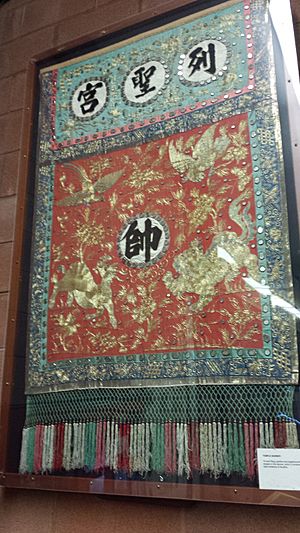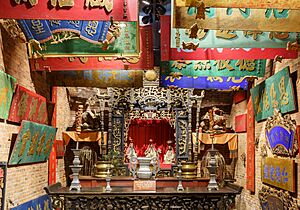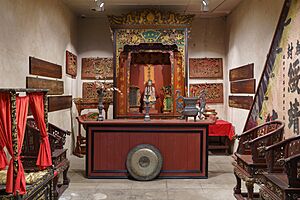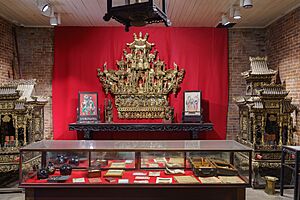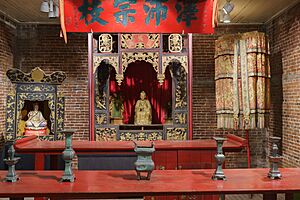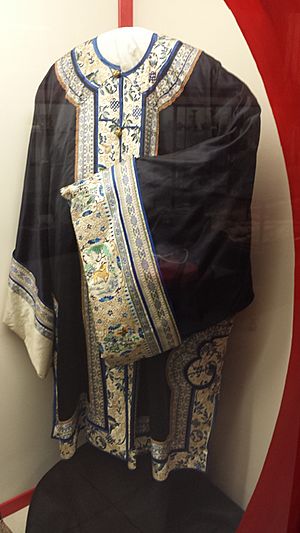Oroville Chinese Temple facts for kids
Quick facts for kids |
|
|
Oroville Chinese Temple
|
|
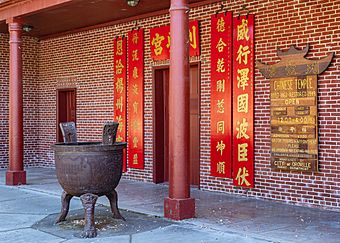 |
|
| Location | 1500 Broderick St., Oroville, California |
|---|---|
| Built | 1863 |
| NRHP reference No. | 76000478 |
| Added to NRHP | July 30, 1976 |
The Oroville Chinese Temple (列聖宮) is a special place in Oroville, California. It's a Chinese folk religious temple that was built way back in 1863. Today, the City of Oroville owns it, and you can visit it as a museum. People still use it sometimes for worship, keeping its traditions alive.
Contents
A Look at the Temple's History
Chinese Settlers and the Gold Rush
In the late 1800s, many Chinese came to the Oroville, California area. About 10,000 Chinese settlers lived there at one point. Like many others, they came mainly to find gold during the California Gold Rush, which started around 1849.
For the first 20 years, mostly men came from places like Canton and Shanghai. They couldn't bring their families. They carried their rich culture and a strong desire to succeed. They hoped to earn money and return home wealthy.
Building the Temple
Around 1850, the Chinese community in Oroville worked together. They gathered their money and built the first Chinese temple. This first temple was made of wood, but it burned down. A second temple was built, but it also burned.
The third temple was much stronger. It was built with red brick from Palermo, California. The Tongzhi Emperor and Empress Xiaozheyi helped pay for it. This temple was finished in September 1863, and it's the same building you can see today.
Challenges and New Beginnings
The temple survived many fires and floods over the years. But in 1907, a huge flood damaged the temple and the whole Oroville area. At the same time, there was an economic depression in the United States. Because of these problems, many Chinese people left Oroville. They moved to bigger U.S. cities or went back to China.
The remaining Chinese families, especially the Chan family, kept the temple complex going until the 1930s. In the 1930s, these families decided to give the temple to the City of Oroville. The city officially took ownership in 1937.
The Chinese families had three important requests for the city:
- The city would build a museum to show artifacts that the temple didn't have space for.
- All three temple rooms would stay open for the community to use for worship.
- Volunteers would learn about Chinese culture, beliefs, and artifacts. This way, visitors could better understand the temple.
After the new museum building was finished, the center reopened to visitors in July 1949. The temple originally had three main parts: the Chan Room for Confucian meditation, the Moon Temple for Buddhist ceremonies, and the Council Room for community meetings. Later, new parts were added, like a Chinese tapestry hall, a display hall, and a Chinese garden.
The Chinese Temple museum reopened to the public on April 10, 2021. It had been closed for a year due to health restrictions. Today, the museum is open on Wednesdays and Saturdays from 10 a.m. to 2 p.m.
Exploring the Original Temple Rooms
Main Temple: Liet Sheng Kong
The oldest brick temple was finished in 1863. It is called Liet Sheng Kong, which means "Temple of Many Gods and Goddesses." In this temple, visitors could worship any deity they chose. The ceiling and walls are covered with hanging boards. These boards have carvings or writings that honor Chinese deities for answering prayers.
The room has three altars. One teak altar at the front came from China. It shows a beautifully carved courtyard scene. A second altar holds incense burners. The third altar, also from China, sits at the back wall. This altar holds three carved wooden statues of Chinese deities. On the top sides of this altar are two papier-mâché Southern lion heads. The Chinese used these heads to scare away evil spirits. They also used them in Chinese festival parades. Inside the temple, there is a gong. Outside the entrance, there is a very large ceremonial urn that also came from China.
Chan Room: A Place of Remembrance
The Chan Room was built in 1864, next to the Main Temple. It is also called "Suey Cing Bak." This room was built to remember General Chan Low Kwan from the Soong Dynasty. He was also known as the "Viscount of Purification." All people named Chan or Chin from a certain area in Guangdong province were direct descendants of Chan Low Kwan.
This room has many artifacts. One very special item is a large, teak bridal sedan chair. It is of Chinese Imperial Palace quality. This chair had curtains and was used in parades and wedding ceremonies.
Council Room: For Community Matters
The Council Room was built in 1868. It has a beautiful hanging screen made of carved wood with gold leaf on it. There are also two procession shrines in the room. These shrines were carried in parades during Chinese festivals.
The room was mostly used for business deals. In the late 1800s, few Chinese people in Oroville could read or write. So, it is thought that the few educated Chinese men helped others record their business transactions.
Moon Room: Devoted to Buddha
The Moon Room, or "Wong Fut Tong," was built in 1868. It is located on the floor above the Council Room. The Moon Room gets its name from its unique circular door. This room is dedicated to Buddha. It has three statues, one of which shows Buddha reaching out his hand to display the "sign of wisdom." The main color in the room is red, which is a lucky color in the Buddhist tradition.
Later Additions to the Complex
Tapestry Hall: Art and History
The Tapestry Hall was built and opened in 1968. It holds amazing Chinese tapestries and parade umbrellas. You can also see a 16th-century imperial pillar rug, a beautiful bronze urn, and many other Chinese artifacts. A special collection here is antique shadow puppets made from donkey skin. These puppets were used in plays that taught Chinese people about their own culture. They were very important for those who couldn't read or write the Chinese language.
Display Hall: Daily Life and Costumes
This Display Hall also opened in 1968. It was built to show artifacts given to the Chinese Temple. You can see Chinese costumes, furniture, and other items that show what daily life was like for the Chinese.
The room also has tapestries and decorations. One interesting item is a pair of shoes worn by a woman with bound feet. This room also has a collection of large paper mache puppets. The Chinese used these puppets in their theater when actors were not available. Puppeteers who came from China originally brought these puppets to Oroville. They left them behind when many returned to their home country.
Cullie Room: A Bicentennial Gift
This room was added to the complex in 1976 as an American Bicentennial project. Charlotte Cullie, a kind person from the area, gave money for the project. The clothing and artifacts in the room were donated by two Chinese missionaries, Mabel Clay and Jessie Mae Henke.
A special part of the collection is mannequins showing Chinese and United States historical clothing styles from 1840 to 1940. This collection was given to the city of Oroville in 1976.
Garden: A Peaceful Place
The courtyard garden was created in 1968. It has plants that are native to China. A few annual flowers are added each year for extra color. The garden also has a pond with lily pads and koi fish.
The Chinese garden style has been around for over three thousand years. Historically, these gardens are peaceful places for prayer, meditation, and quiet talks.
Workers Hut: A Miner's Home
In 1976, a historical replica of a Chinese gold miner's hut was built. It was made from barn wood dating back to the 1860s. It was first shown as a Butte County exhibit at the California State Fair. Later, it was donated to be an exhibit at the Oroville Chinese Temple grounds.
Fong Lee Room: A Shop Replica
The newest room at the Oroville Chinese Temple was paid for by the Chin (Chan) Shew Ting family trust. It honors Chin Kong Yu, who was one of the first Chinese shopkeepers in the Oroville area. This room opened on April 16, 2008. It has a Chinese apothecary cabinet that was originally used to hold herbal remedies. The room also has old gold scales and items used for gold transactions. The room looks like a replica of Chin Kong Yu's original shop. It has light fixtures, cabinets, cases, and other items from his shop in the late 1800s.
Other Chinese Temples to Explore
- Auburn Joss House, located in Auburn, California
- Temple of Kwan Tai (武帝廟) located in Mendocino, California
- Bok Kai Temple (北溪廟) located in the city of Marysville, California
- Kong Chow Temple (岡州古廟) located in San Francisco, California
- Tin How Temple (天后古廟) in San Francisco's Chinatown, California
- Ma-Tsu Temple (美國舊金山媽祖廟朝聖宮) in San Francisco's Chinatown, California
- Weaverville Joss House (雲林廟), located in the center of the town of Weaverville, California
- National Register of Historic Places listings in Butte County, California




